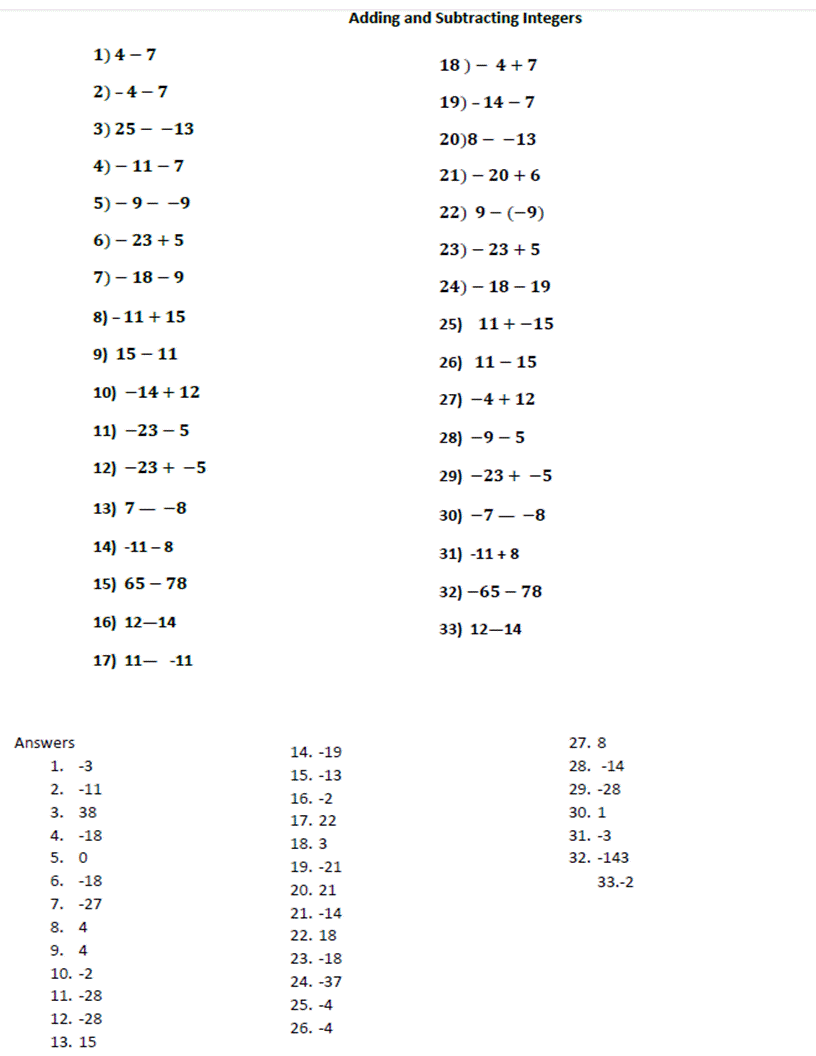Integer Arithmetic: Decode the Secrets of Adding and Subtracting
Imagine a world without numbers. Impossible, right? Now, imagine a world where we could only count upwards. Even more limiting. Integers, those whole numbers including negatives, zeros, and positives, form the bedrock of mathematics, and manipulating them through addition and subtraction is fundamental to understanding how our numerical universe functions. This journey into the realm of integer arithmetic will equip you with the knowledge to navigate these fundamental operations with confidence.
Adding and subtracting integers might seem like elementary school stuff, but these operations are the foundation of more complex mathematical concepts, including algebra, calculus, and even coding. From balancing a checkbook to calculating profit margins, understanding integer manipulation is a critical life skill that extends far beyond the classroom.
The concept of negative numbers wasn't always readily embraced. Ancient civilizations primarily dealt with positive quantities. The need for negative numbers arose in contexts like debt and losses. Indian mathematicians are credited with formalizing the rules for working with negative numbers, a concept later adopted and expanded by Islamic scholars and eventually integrated into Western mathematics. This historical development underscores the importance of integer arithmetic as a tool for representing and solving real-world problems.
One of the key challenges in integer arithmetic involves understanding the interaction of signs. Adding two positive integers is straightforward. However, adding a positive and a negative integer requires grasping the idea of "canceling out" or reducing magnitude. Subtracting integers often trips people up, especially when subtracting a negative number. This confusion often stems from not fully internalizing the concept of "the opposite of a negative" being a positive.
Let's define our terms. Integers are whole numbers without fractional or decimal components. They can be positive, negative, or zero. Addition is the process of combining two or more integers to find their sum. Subtraction is the process of finding the difference between two integers. A simple example: 5 + (-3) = 2. Here, positive 5 combined with -3 results in 2. Similarly, 5 - (-3) = 8. Subtracting a negative is equivalent to adding a positive.
Benefits of understanding integer operations are numerous. First, it strengthens foundational math skills, enabling a smoother transition to more advanced mathematical concepts. Second, it enhances problem-solving abilities, as many real-world problems require manipulating integers, from calculating temperature changes to managing finances. Third, a strong grasp of integer arithmetic is invaluable in various fields, including science, engineering, and computer programming.
A simple action plan for mastering integer operations: Start with understanding the number line. Visualize addition as moving right and subtraction as moving left. Practice with numerous examples, starting with simpler problems and progressing to more complex ones. Use online resources and worksheets to reinforce your understanding.
Step-by-step guide: To add integers with the same sign, add their absolute values and keep the sign. To add integers with different signs, subtract the smaller absolute value from the larger absolute value and use the sign of the integer with the larger absolute value. To subtract an integer, add its opposite.
Advantages and Disadvantages of Working with Integers
| Advantages | Disadvantages |
|---|---|
| Foundation for higher math | Can be initially confusing, especially subtraction of negatives |
| Essential for real-world problem-solving | Doesn't address situations involving fractions or decimals |
| Used in diverse fields |
Best Practices: 1. Utilize the number line for visualization. 2. Master the rules of signs. 3. Practice regularly. 4. Seek help when needed. 5. Relate integer operations to real-world scenarios.
Real-world examples: 1. Temperature changes. 2. Financial transactions. 3. Elevation differences. 4. Sports scores. 5. Inventory management.
FAQs: 1. What is an integer? 2. How do I add integers with different signs? 3. Why does subtracting a negative become addition? 4. What is the absolute value of an integer? 5. How can I use integers in real life? 6. What's the difference between an integer and a whole number? 7. What are some common mistakes to avoid when working with integers? 8. How can I improve my integer arithmetic skills?
Tips and tricks: Use the number line. Think of adding a negative as subtracting. Remember that subtracting a negative is the same as adding a positive. Practice with real-world scenarios.
In conclusion, understanding integer arithmetic—specifically, the addition and subtraction of integers—is a critical building block for mathematical literacy. From its historical origins to its widespread applications in diverse fields, the power and utility of integer manipulation are undeniable. Mastering these operations empowers individuals to solve problems, make informed decisions, and confidently navigate a world increasingly reliant on numerical reasoning. Take the time to practice, utilize online resources, and embrace the challenges presented by integer arithmetic. The benefits far outweigh the initial effort, unlocking a deeper understanding of mathematics and its crucial role in our lives. By mastering these fundamental concepts, you equip yourself with the tools to not only succeed in academics but also to analyze, interpret, and ultimately shape the world around you.

FREE Printable Adding And Subtracting Integers Worksheets PDFs | Kennecott Land

Negative And Positive Rules Chart | Kennecott Land

Adding Integers Subtracting Integers worksheet | Kennecott Land

Grade 7 Maths Worksheets Integers Pdf | Kennecott Land

adding and subtracting integers | Kennecott Land

Number Line Integers Worksheet | Kennecott Land

Integers Adding And Subtracting Worksheets | Kennecott Land

FREE Printable Adding And Subtracting Integers Worksheets PDFs | Kennecott Land

Adding And Subtracting Negative Integers | Kennecott Land

FREE Printable Adding And Subtracting Integers Worksheets PDFs | Kennecott Land

How To Add Negative Integers | Kennecott Land

Adding And Subtracting Integers On A Number Line Worksheets | Kennecott Land

Adding Positive and Subtracting Integers | Kennecott Land

Adding And Subtracting Integers Worksheets | Kennecott Land

Adding and Subtracting Integers worksheet for 3 | Kennecott Land